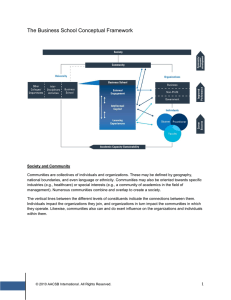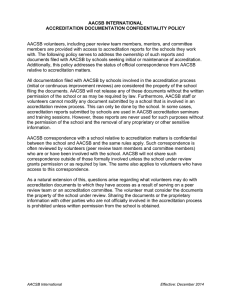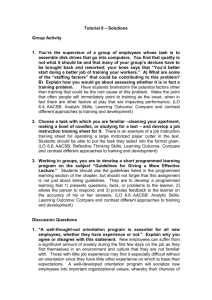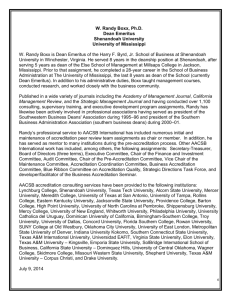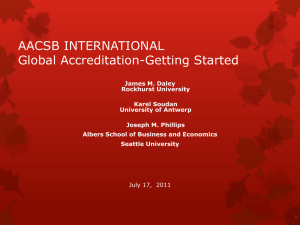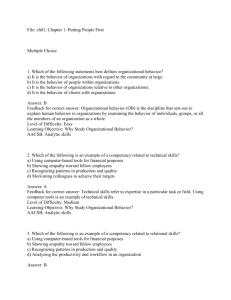AACSB Accreditation Standards Worksheet
advertisement
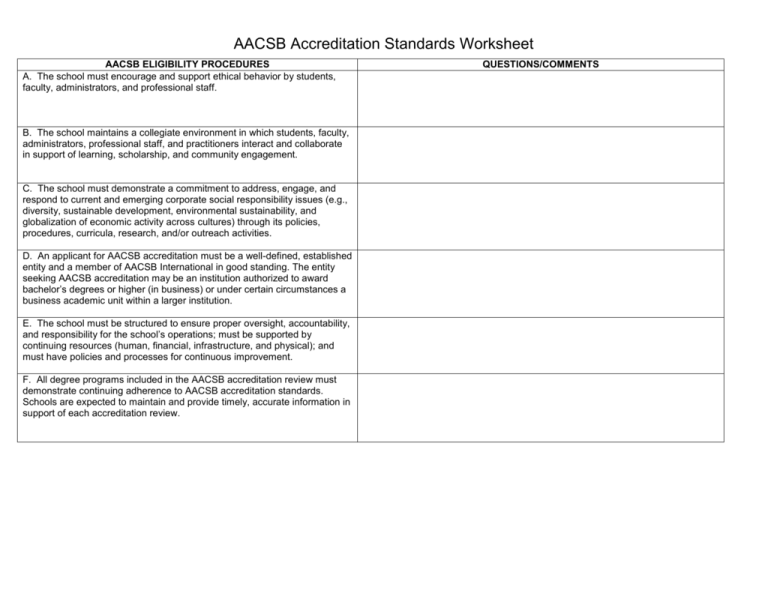
AACSB Accreditation Standards Worksheet AACSB ELIGIBILITY PROCEDURES A. The school must encourage and support ethical behavior by students, faculty, administrators, and professional staff. B. The school maintains a collegiate environment in which students, faculty, administrators, professional staff, and practitioners interact and collaborate in support of learning, scholarship, and community engagement. C. The school must demonstrate a commitment to address, engage, and respond to current and emerging corporate social responsibility issues (e.g., diversity, sustainable development, environmental sustainability, and globalization of economic activity across cultures) through its policies, procedures, curricula, research, and/or outreach activities. D. An applicant for AACSB accreditation must be a well-defined, established entity and a member of AACSB International in good standing. The entity seeking AACSB accreditation may be an institution authorized to award bachelor’s degrees or higher (in business) or under certain circumstances a business academic unit within a larger institution. E. The school must be structured to ensure proper oversight, accountability, and responsibility for the school’s operations; must be supported by continuing resources (human, financial, infrastructure, and physical); and must have policies and processes for continuous improvement. F. All degree programs included in the AACSB accreditation review must demonstrate continuing adherence to AACSB accreditation standards. Schools are expected to maintain and provide timely, accurate information in support of each accreditation review. QUESTIONS/COMMENTS AACSB STRATEGIC MGMT. AND STANDARDS 1. Mission, Impact, and Innovation QUESTIONS/COMMENTS The school articulates a clear and distinctive mission, the expected outcomes this mission implies, and strategies outlining how these outcomes will be achieved. The school has a history of achievement and improvement and specifies future actions for continuous improvement and innovation consistent with this mission, expected outcomes, and strategies. 2. Intellectual Contributions, Impact, and Alignment with Mission The school produces high-quality intellectual contributions that are consistent with its mission, expected outcomes, and strategies and that impact the theory, practice, and teaching of business and management. 3. Financial Strategies and Allocation Of Resources The school has financial strategies to provide resources appropriate to, and sufficient for, achieving its mission and action items. AACSB PARTICIPANTS – STUDENTS, FACULTY, AND PROFESSIONAL STAFF STANDARDS 4. Student Admissions, Progression, and Career Development Policies and procedures for student admissions, as well as those that ensure academic progression toward degree completion, and supporting career development are clear, effective, consistently applied, and aligned with the school's mission, expected outcomes, and strategies. 5. Faculty Sufficiency and Deployment The school maintains and deploys a faculty sufficient to ensure quality outcomes across the range of degree programs it offers and to achieve other components of its mission. Students in all programs, disciplines, locations, and delivery modes have the opportunity to receive instruction from appropriately qualified faculty. 6. Faculty Management and Support The school has well-documented and well-communicated processes to manage and support faculty members over the progression of their careers that are consistent with the school’s mission, expected outcomes, and strategies. 7. Professional Staff Sufficiency and Deployment The school maintains and deploys professional staff and/or services sufficient to ensure quality outcomes across the range of degree programs it offers and to achieve other components of its mission QUESTIONS/COMMENTS AACSB LEARNING AND TEACHING STANDARDS 8. Curricula Management and Assurance Of Learning QUESTIONS/COMMENTS The school uses well-documented, systematic processes for determining and revising degree program learning goals; designing, delivering, and improving degree program curricula to achieve learning goals; and demonstrating that degree program learning goals have been met. 9. Curriculum Content Curriculum content is appropriate to general expectations for the degree program type and learning goals. 10. Student-Faculty Interactions Curricula facilitate student-faculty and student-student interactions appropriate to the program type and achievement of learning goals.. 11. Degree Program Educational Level, Structure, and Equivalence Degree program structure and design, including the normal time-to-degree, are appropriate to the level of the degree program and ensure achievement of high-quality learning outcomes. Programs resulting in the same degree credential are structured and designed to ensure equivalence. 12. Teaching Effectiveness The school has policies and processes to enhance the teaching effectiveness of faculty and professional staff involved with teaching across the range of its educational programs and delivery modes. AACSB ACADEMIC AND PROFESSIONAL ENGAGEMENT STANDARDS 13. Student Academic and Professional Engagement Curricula facilitate student academic and professional engagement appropriate to the degree program type and learning goals. 14. Executive Education If applicable, executive education (activities not leading to a degree) complements teaching and learning in degree programs and intellectual contributions. The school has appropriate processes to ensure high quality in meeting client expectations and continuous improvement in executive education programs. QUESTIONS/COMMENTS 15. Faculty Qualifications And Engagement The school maintains and strategically deploys participating and supporting faculty who collectively and individually demonstrate significant academic and professional engagement that sustains the intellectual capital necessary to support high-quality outcomes consistent with the school’s mission and strategies.



